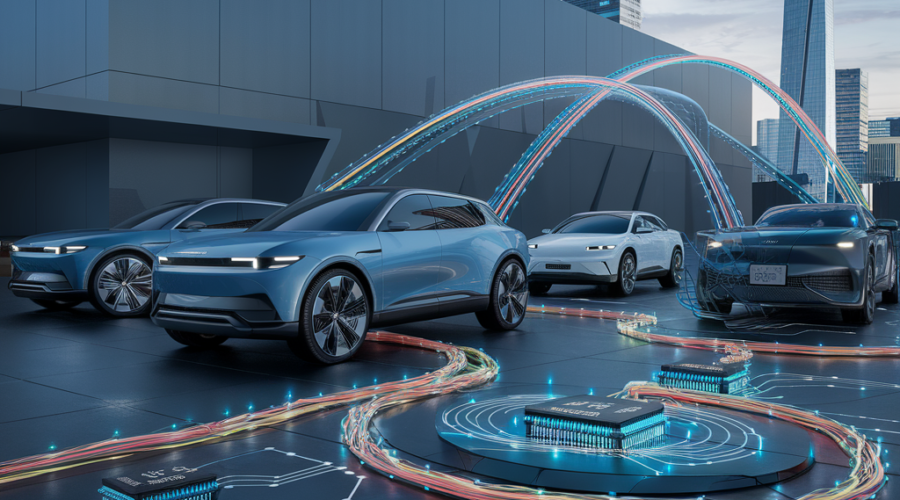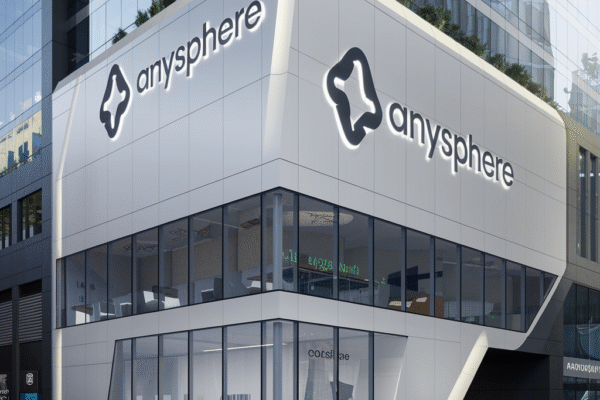In a move that consolidates its dominance in automotive semiconductors, Infineon Technologies AG has announced the acquisition of Marvell Technology’s Automotive Ethernet business for $2.5 billion in cash[1][2][4][6]. The transaction, expected to close by year-end 2025 pending regulatory approvals, positions the German chipmaker at the forefront of vehicle architecture transformation as automakers accelerate their shift toward software-defined vehicles. The deal combines Infineon’s market-leading AURIX microcontrollers with Marvell’s high-speed networking technology, creating a comprehensive solution for next-generation automotive computing needs while opening new frontiers in physical AI applications[1][4][6].
Strategic Rationale: Building the Nervous System of Future Vehicles
Architectural Shift in Automotive Design
The automotive industry’s transition from distributed electronic control units (ECUs) to centralized domain architectures has created unprecedented demand for high-bandwidth, low-latency communication systems. Modern vehicles now require data transfer rates exceeding 10 Gbps to support advanced driver assistance systems (ADAS), autonomous driving capabilities, and over-the-air (OTA) updates[1][4][6]. Marvell’s Brightlane Ethernet portfolio – supporting speeds from 100 Mbps to industry-leading 10 Gbps – provides the critical backbone for these architectures, complementing Infineon’s microcontroller dominance[1][4][6].
Synergy Potential with AURIX Platform
Infineon’s AURIX microcontrollers, installed in 80% of global vehicles, will gain enhanced system integration capabilities through direct coupling with Marvell’s Ethernet PHY transceivers and switches[1][4][6]. This combination enables real-time control networks capable of processing sensor data from lidar, radar, and camera systems within deterministic timeframes – a critical requirement for autonomous vehicle certification[1][6]. The integration creates a vertically optimized solution that could reduce automakers’ development cycles by 6-9 months according to industry benchmarks[4].
Financial Engineering: Balancing Growth and Leverage
Immediate Financial Impact
The acquired business is projected to generate $225-250 million in 2025 revenue with a 60% gross margin, immediately accretive to Infineon’s automotive segment margins[1][4][6][8]. At 10x revenue multiple, the deal valuation reflects premium positioning in high-growth automotive networking markets. Infineon plans to fund the acquisition through existing liquidity and new debt, temporarily increasing leverage ratios but maintaining investment-grade credit metrics[1][4][6].
Long-Term Value Creation
With a $4 billion design-win pipeline through 2030[1][4][6], the transaction positions Infineon to capture 35-40% of the automotive Ethernet market within three years. Cost synergies from combined R&D ($50 million annual savings) and manufacturing integration (15-20% cost reduction on Marvell products) should boost operating margins to 25% by 2027[4][6]. The deal’s internal rate of return (IRR) is estimated at 12-14%, exceeding Infineon’s weighted average cost of capital[1].
Technology Integration: Creating the Automotive Computing Standard
Hardware-Software Convergence
The merger enables Infineon to offer complete zonal architecture solutions combining AURIX TC4x microcontrollers with Marvell’s 10Gbps Ethernet switches[1][4][6]. This integration addresses automakers’ need for deterministic network timing (<1μs jitter) required for brake-by-wire and steer-by-wire systems[6]. Security features including hardware-based intrusion detection and encrypted communication channels meet ASIL-D safety standards, critical for ISO 21434 compliance[1][4].
Software-Defined Vehicle Ecosystem
Infineon’s acquisition accelerates its transition from component supplier to systems architect. By combining network controllers with real-time processing cores, the company can now offer pre-validated software stacks for AUTOSAR Adaptive platforms – reducing OEM integration effort by an estimated 30%[4][6]. This positions Infineon as a key enabler for vehicle-as-a-service models requiring continuous software updates throughout 15+ year vehicle lifecycles[1].
Market Implications: Reshaping Competitive Dynamics
Competitive Landscape Shift
The deal creates a new axis of competition in automotive semiconductors, pitting Infineon’s integrated computing/networking solution against NXP’s S32 platform and Texas Instruments’ Jacinto processors[4][6]. With 8 of the top 10 automakers now using combined Infineon-Marvell technology[1][4], competitors face pressure to match system-level capabilities through partnerships or acquisitions. Potential consolidation targets include Ethernet specialists like Microchip Technology or Realtek Semiconductor[6].
Supply Chain Considerations
Infineon gains Marvell’s established relationships with Tier 1 suppliers including Bosch, Continental, and Aptiv[1][4][6]. This vertical integration reduces dependency on third-party network IC suppliers while strengthening pricing power. The combined entity could command 15-20% premiums for integrated safety-certified solutions compared to discrete component offerings[4].
Risk Assessment: Navigating Integration Challenges
Cultural and Operational Integration
Integrating Marvell’s 300+ person automotive team across three continents presents logistical challenges[4][6]. Differences in design methodologies – Marvell’s fabless model versus Infineon’s IDM structure – require careful alignment of product roadmaps. Retention packages for key Marvell engineers could add $30-50 million in near-term costs[1].
Regulatory Hurdles
While no antitrust red flags are immediately apparent, regulators may scrutinize Infineon’s strengthened position in automotive microcontrollers where it already holds 40% market share[1][4]. Potential remedies could include licensing agreements for Ethernet patents or firewall provisions between microcontroller and networking divisions[6].
Future Horizons: Beyond Automotive
Physical AI Applications
Infineon’s mention of humanoid robot applications signals broader ambitions in embodied AI[1][4][6]. The acquired Ethernet technology’s low-latency characteristics (sub-100ns) make it suitable for industrial robots and collaborative automation systems. This positions Infineon to address a $12 billion market for industrial networking components by 2030[4].
Edge Computing Convergence
The combination of real-time control and high-speed networking creates opportunities in edge AI infrastructure. Future vehicle architectures could leverage Infineon’s chips for distributed inferencing – processing sensor data locally while maintaining cloud connectivity[1][6]. This capability becomes critical as L4 autonomous vehicles generate 4TB of data per hour[4].
Conclusion: A Paradigm Shift in Automotive Electronics
Infineon’s strategic acquisition redefines the automotive semiconductor landscape, creating a vertically integrated supplier capable of delivering complete software-defined vehicle architectures. While the $2.5 billion price tag reflects aggressive market positioning, the deal’s synergies and growth potential justify the premium. As automakers accelerate their software roadmaps, Infineon emerges as the gatekeeper for vehicle digital transformation – a position that could yield decade-long dominance in automotive electronics. The transaction also signals broader industry trends toward system-level solutions, likely triggering further consolidation among semiconductor suppliers racing to meet automakers’ evolving technology demands.
Sources
https://www.stocktitan.net/news/IFNNY/infineon-further-strengthens-its-number-one-position-in-automotive-garc7cswkcx1.html, https://www.finanznachrichten.de/nachrichten-2025-04/65050473-marvell-agrees-to-sell-automotive-ethernet-business-to-infineon-for-dollar-2-5-bln-020.htm, https://markets.businessinsider.com/news/stocks/marvell-sells-automotive-ethernet-business-to-infineon-for-2-5b-in-cash-1034557739, https://www.finanznachrichten.de/nachrichten-2025-04/65050621-infineon-technologies-ag-infineon-further-strengthens-its-number-one-position-in-automotive-microcontrollers-and-boosts-systems-capabilities-for-soft-004.htm, https://www.streetinsider.com/Corporate+News/Marvell+Technology+(MRVL)+to+Sell+Automotive+Ethernet+Business+to+Infineon+for+$2.5B+Cash/24609713.html, https://www.infineon.com/cms/en/about-infineon/press/press-releases/2025/INFXX202504-086.html, https://www.gurufocus.com/news/2765873/infineon-ifx-acquires-marvells-automotive-ethernet-business-for-25-billion?r=4bf001661e6fdd88d0cd7a5659ff9748, https://www.webdisclosure.com/article/infineon-to-acquire-marvells-automotive-ethernet-unit-for-25-billion-O8uEe0Jh2sv





